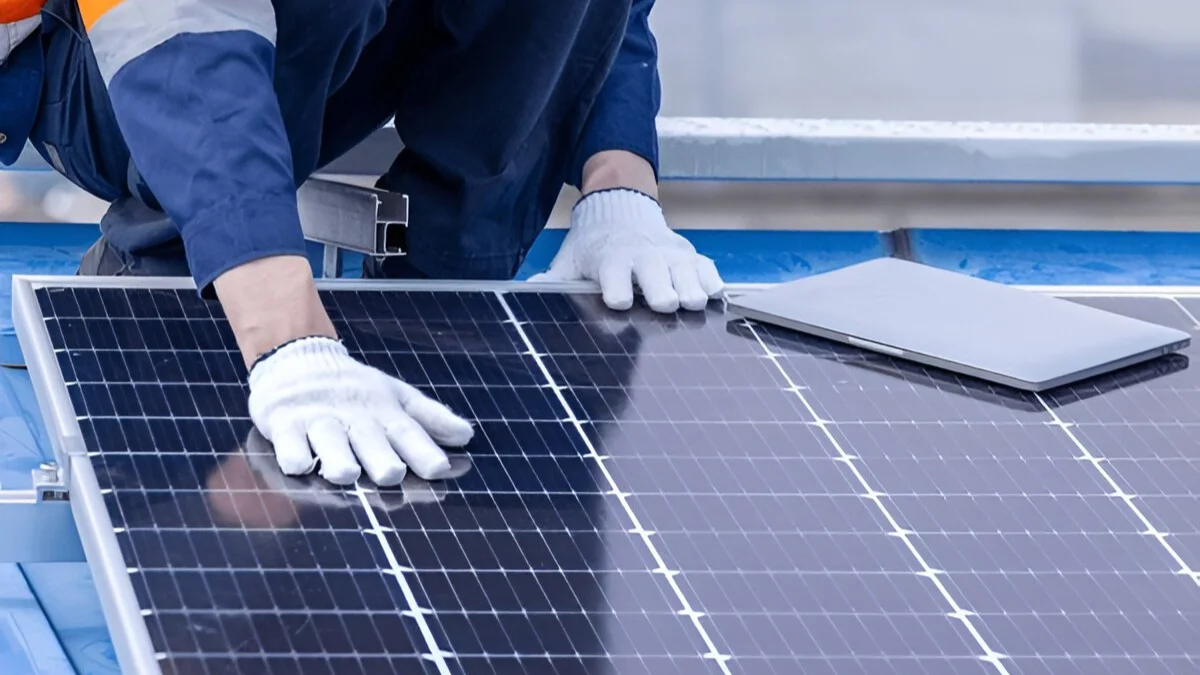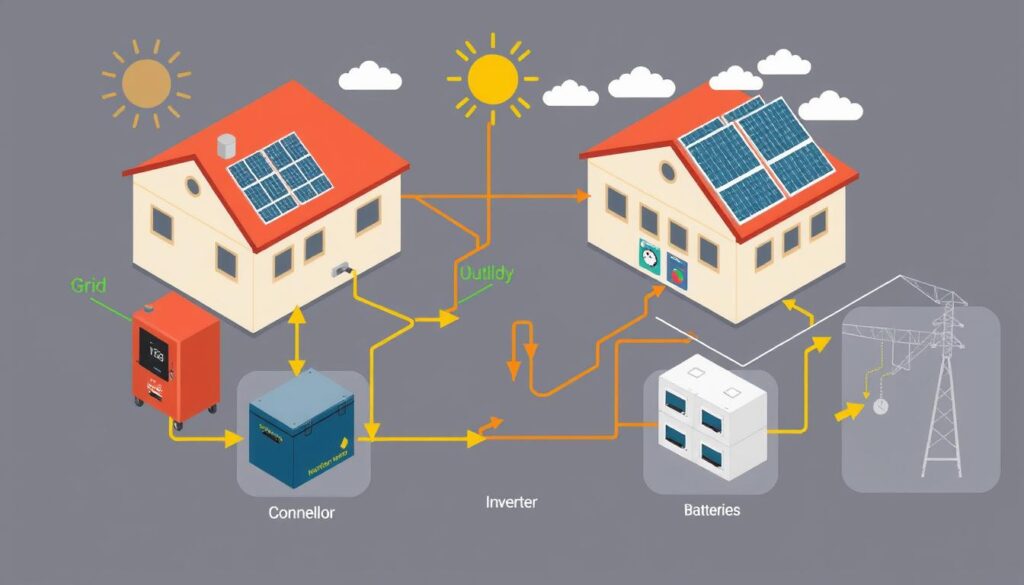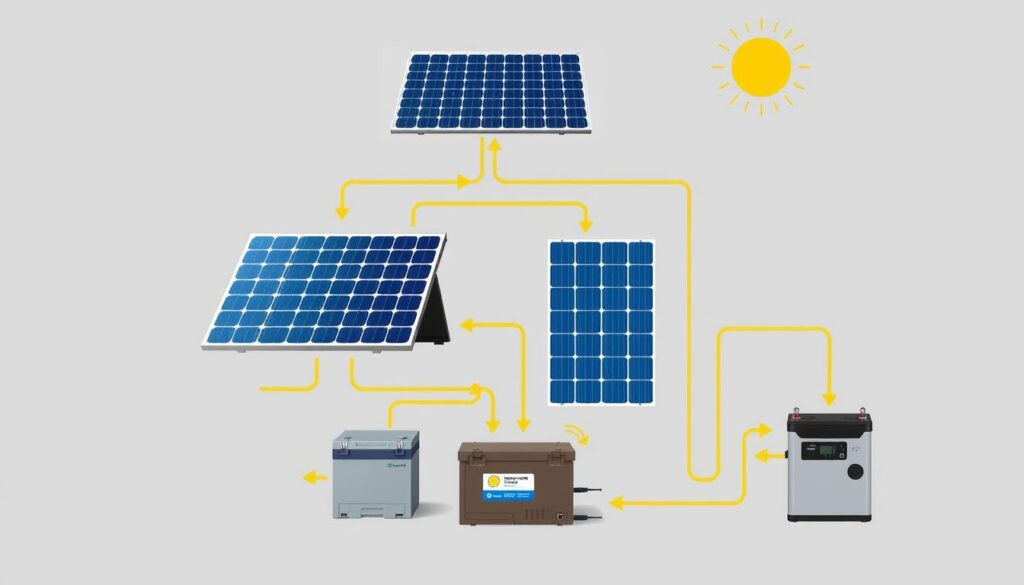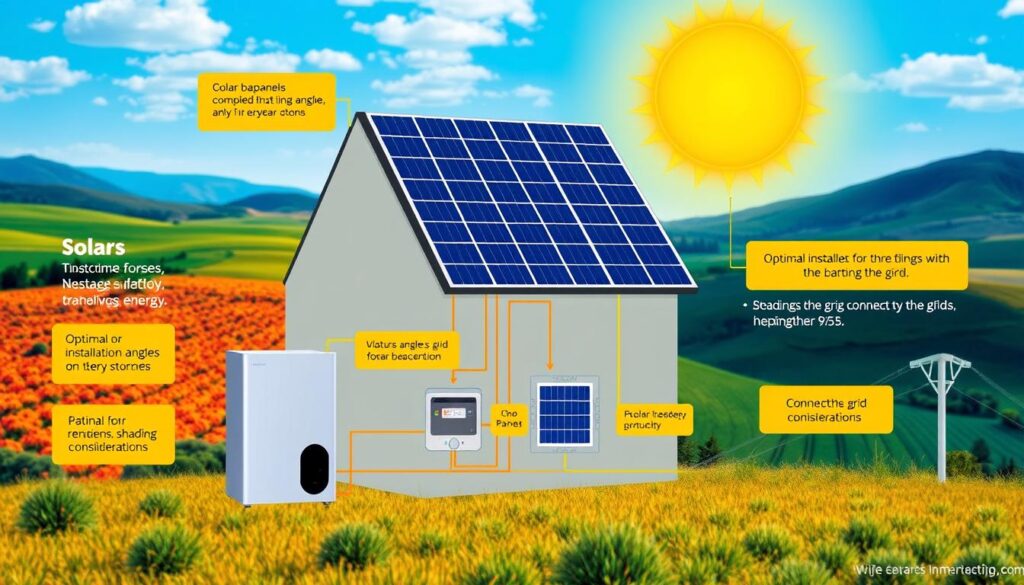
Thinking about renewable energy makes me realize how key a solar energy system diagram is. It’s vital for designing and setting up a solar power system. A good diagram shows the parts and how they connect, making sure the system is safe and works well.
With more people wanting renewable energy, having a detailed solar power plan is crucial. A solar energy system diagram is a key tool to reach this goal. It’s also linked to a renewable energy layout.
Table of Contents: solar energy system diagram
Key Takeaways: solar energy system diagram
- A solar energy system diagram is essential for designing and installing a solar power system.
- A well-designed solar power schematic maximizes energy production and ensures a safe installation.
- A renewable energy layout is critical in achieving maximum efficiency in a solar energy system.
- A solar energy system diagram helps visualize the components and their connections.
- Maximizing energy production requires a well-designed solar energy system diagram.
- A solar power schematic is a crucial tool in designing and installing a solar energy system.
- A renewable energy layout is closely related to a solar energy system diagram and solar power schematic.

Understanding Your Solar Energy System Diagram
To make a solar energy system work well, you need to know the main parts and how they connect. A photovoltaic system drawing shows this. It includes solar panels, inverters, mounting systems, and batteries. Let’s look at each part and how they work together.
A solar energy schematic is key to seeing how these parts interact. It helps you make sure your system is safe and efficient. Knowing how power moves through the system is also important for its best performance.
Some important things to think about when looking at your solar energy system diagram are:
- Where each part is placed and how they connect, as shown in a photovoltaic system drawing
- How big the system is and how it’s set up, based on a solar panel setup illustration
- How to store and use extra energy, shown in a solar energy schematic
Understanding these points helps you make your solar energy system as efficient as possible. A well-made solar energy system diagram is crucial for a good installation.
Essential Components and Their Functions
When designing a solar system, it’s key to know each part’s role. A good solar panel system layout boosts energy output and cuts losses. The main parts are solar panels, inverters, mounting systems, and batteries.
Solar panels turn sunlight into electricity. Inverters change DC power to AC power, making it ready for homes and businesses. A good solar system design also considers mounting systems and batteries. Mounting systems hold the panels in place, and batteries save extra energy for later.
Here are the main parts of a solar energy system:
- Solar panels: convert sunlight into electricity
- Inverters: convert DC power to AC power
- Mounting systems: secure solar panels in place
- Batteries: store excess energy production
A well-planned solar power diagram ensures the system works well. Knowing each part’s role helps design a system that fits your energy needs. This way, you use less non-renewable energy.
By focusing on the essential components and their roles, you can make a solar system that suits your needs. This approach maximizes energy production.

Maximizing System Performance Through Proper Layout
To get the most out of a solar energy system, a good layout is key. It’s important to look at the photovoltaic system diagram to ensure the best energy output. A well-planned solar setup illustration helps find the best spot for solar panels, wiring, and inverters.
When placing solar panels, think about how much sunlight they’ll get all day. A renewable energy system chart can show the best angle and direction for panels. Following the best practices for wiring and inverter placement can also help. This way, you can cut down on energy loss and boost system performance.
Some important things to think about for better system performance include:
- Optimal panel positioning to maximize sunlight exposure
- Wiring configuration best practices to reduce energy losses
- Inverter placement strategies to optimize energy production
By planning the layout of a solar energy system with a photovoltaic system diagram, you can make sure it works at its best. This not only cuts down on energy costs but also helps the planet.
So, a well-designed solar setup illustration is vital for top system performance. By focusing on the mentioned factors and using a renewable energy system chart, you can build an efficient and effective solar energy system.
| Component | Optimal Placement | Benefits |
|---|---|---|
| Solar Panels | South-facing roof or ground mount | Maximizes sunlight exposure |
| Wiring | Minimized length and insulation | Reduces energy losses |
| Inverter | Near the main electrical panel | Optimizes energy production |
Smart Installation Considerations for Peak Output
Installing a solar energy system right is key to getting the most out of it. You need to think about local building codes, weather, and the environment. A solar energy system diagram helps spot problems and improve the setup. It lets installers plan the system’s layout, considering things like shading and wind direction.
For off-grid systems, the off-grid solar diagram is crucial. It shows if the system can run on its own and meet energy needs. Important things to think about include:
- How much energy you use
- Space for the solar panels
- The local weather and sunlight
- How much power the batteries can hold
By thinking about these points and using a detailed solar energy system diagram, installers can make a system that works well. This means homes and businesses can use clean energy and help the planet.
By keeping these smart installation tips in mind, you can make sure your solar system works great. It will give you clean energy for a long time.
| System Component | Function | Importance |
|---|---|---|
| Solar Panels | Convert sunlight into electricity | High |
| Inverter | Convert DC power to AC power | High |
| Battery Storage | Store excess energy for later use | Medium |

Conclusion: solar energy system diagram
A well-designed solar panel system layout is key to getting the most out of your investment. By following the tips in this article, you can make sure your system works at its best. It will also grow with your changing energy needs.
Keeping your solar panel system in top shape is vital. Watch for any drops in performance or issues. This way, you can fix problems quickly and avoid expensive repairs or system failures. Also, think about upgrading or expanding your system as new tech comes out. This will keep your investment strong and save you money in the long run.
Investing in a good solar energy system does more than cut your bills. It also helps the planet. Learn about your system’s parts and how they work. Make smart choices to keep your investment working for you for many years.
FAQ: solar energy system diagram
What are the core components of a solar power system?
A solar power system has solar panels, inverters, mounting systems, and batteries. These parts work together to turn sunlight into electricity you can use.
How do I read and interpret a solar energy system schematic?
To understand a solar energy system schematic, know the basic flow of power. The diagram shows how components are connected and how electricity moves through the system.
What are the best practices for optimal panel positioning?
For the best panel positioning, think about the sun’s path, shading, and your roof’s orientation. This ensures your panels get the most sunlight all day.
How do I configure the wiring for maximum efficiency?
To wire efficiently, use the right wire gauges and keep wiring runs short. Also, make sure connections are secure at every junction.
Where is the best location to install the inverter?
Choose a spot for the inverter based on ease of access, ventilation, and closeness to panels. It should be in a shaded, well-ventilated area for better performance and life.
How do I ensure my solar energy system is future-proofed?
To keep your system ready for the future, maintain it regularly, monitor its performance, and plan for upgrades. Clean panels, check for problems, and be ready to expand as your energy needs increase.
